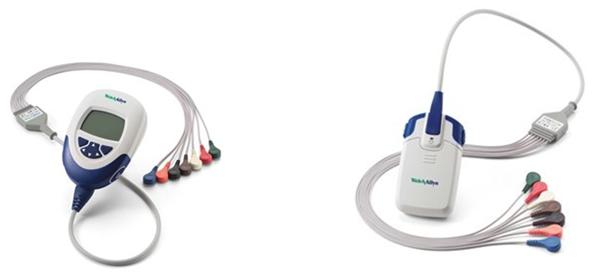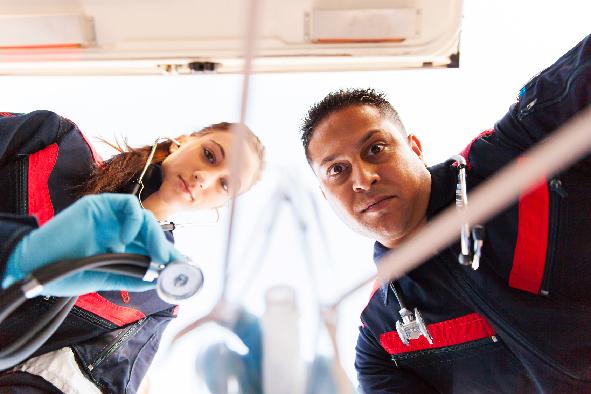|
The Rhythm of the Heart Holter Monitor The heart is the strongest muscle in the human body, and it’s also astonishingly active. Whether we’re running, lying on the couch, or sleeping, the heart unceasingly continues its mission to pump blood through our bodies. On average, the human heart beats over 115 thousand times a day. Therefore it is literally vital to keep our hearts in prime condition—but lifestyle choices, illness, and the aging process all combine to make this task increasingly difficult as time goes by. Luckily, medical technology has produced a variety of effective devices and treatments to aid us in remaining heart-healthy. Among these helpful medical advances is the Holter monitor, which can be used to monitor an individual’s heartbeat activity, or electrocardiogram (ECG). Let’s take a closer look at this device and its benefits.
What is a Holter Monitor? A Holter monitor is a medical device that measures the patient’s heart activity (ECG) for a 24-to-48-hour period. The device is fairly small and can be easily hooked onto the patient’s belt or slung over their shoulder. It includes wires that attach to electrodes, which are strategically placed on the patient’s chest. Once set up properly, the Holter monitor allows the physician to analyze and interpret a person’s ECG reading. A Holter monitor is a medical device that measures the patient’s heart activity (ECG) for a 24-to-48-hour period. The device is fairly small and can be easily hooked onto the patient’s belt or slung over their shoulder. It includes wires that attach to electrodes, which are strategically placed on the patient’s chest. Once set up properly, the Holter monitor allows the physician to analyze and interpret a person’s ECG reading. A standard ECG can measure the activity of the heart for only a few minutes or however long a physician can manage while the patient is inside the medical office. With a Holter monitor, however, the measuring process can last much longer and produce more precise data as to what is causing the patient’s cardiac issues. The patient is able to continue with their everyday activities while generating data that the doctor can analyze to zero in on the nature of the problem. For example, if a patient in a 24-hour span suffers several episodes of chest pain, the doctor can view the ECG readings for those exact times, potentially giving them valuable medical insight. What is a Holter Monitor? The Holter monitor was developed at the Holter Research Laboratory by Norman J. Holter and Dr. Bill Glasscock. Holter’s plan was to devise a reliable way to record the electrophysiological activity of people as they carried on with their everyday activities, as opposed to the traditional practice of collecting data while the patient was in the doctor’s office. Holter’s first radio electrocardiogram (RECG) experiment occurred in or around 1947. During this initial test, Holter was forced to wear around 80 lbs. of cumbersome measuring equipment across his back as he rode on a stationary bicycle. As Holter noted years later, this test was an important step forward in medical technology: “The 85 lb. RECG, while not practical, represented a major breakthrough since before that time a patient had to lie quietly. Our greatest contribution was a radical one and was the beginning of an era where one could take ECG’s on skiers, parachute jumpers, runners, and just about any other type of vigorous physical activity.” Technological improvements—specifically the development of the transistor—soon made RECG obsolete, and the dream of making Holter’s device manageably small suddenly seemed very possible, as it was now a realistic proposition to fit all of its parts inside one piece of equipment. Ideally, Holter wanted his device to be smaller than a pack of cigarettes.
In 1961, Holter conducted the first ambulatory electrocardiograms (AECG). Several news articles were published about Holter and his achievement, and before long a number of prominent doctors, hospitals, and medical professionals began voicing interest in the revolutionary medical device.
Holter realized he needed a partner to help manufacture his heart monitor—and in 1962, he found what he was searching for when he met with Bruce Del Mar and Del Mar Engineering Laboratories. They teamed up to create a smaller and lighter electrocardiogram measuring device, beginning a successful collaboration based on innovation, problem-solving, and mutual respect. Del Mar wrote to Holter in 1965 after several successful tests, "We have continually improved circuitry and mechanical details to obtain greater service fidelity, accuracy, response, and reliability. The instruments we are now delivering are performing very well in the field. We should, however, be thinking and actively working ahead on new model improvements for 1966. Can I have your suggestions in this respect? That would be very much appreciated.”
After Holter received a patent for his device on
November 2, 1965, the Holter Research Foundation sold the exclusive rights to Del Mar Engineering Laboratories, which worked on upgrading and perfecting the monitor over the next 40 years. Del Mar improved on what Holter started by utilizing modern technology to grade any cardiac abnormalities. While the first Holter monitors weighed over eighty pounds, they soon dropped to thirty, to ten, and eventually to less than one pound. The patient’s daily activities could be recorded and interpreted over the course ofa normal day, including sleep, with the use of an extremely lightweight device. At one time, data storage tended to involve reel-to-reel tapes and cassettes. Today’s devices, however, utilize flash memory devices that are able to analyze the ECG readings automatically. With this enormous success behind him, Holter went on to enjoy a career as a professor at the University of California, San Diego. The Association for the Advancement of Medical Instrumentation (AAMI) awarded him the 1979 Laufman-Greatbatch Prize in honor of his achievements. He died on July 21, 1983 in his hometown of Helena, Montana. Who Needs It? People wear a Holter for a number of reasons, but the primary purpose is monitoring heart activity over the span of one or two days. This may be done to achieve any of the following goals:
Wearing a Holter for 24-48 hours poses no serious health risks and does not cause pain. The only issue that sometimes arises is associated with the electrodes, which are attached to the skin with adhesive material that can trigger skin irritation in a minority of patients. The Process of Wearing a Holter Device?
Donning the Holter device begins by attaching the ECG electrodes to the patient’s chest. Wires from the electrodes are then connected to a recorder. From there, the patient wears the recorder for a day or two as they go about their daily lives. The patient is also provided with a diary or log to record how they are feeling during that time span, including any symptoms they experience. For example, if they feel sudden chest discomfort at any point during the day, they should record that incident, and the circumstances in which it occurred, in as much detail as possible.
After the individual wears the Holter for the specified time period, he or she returns to the medical office so the device can be removed and given to the physician, who will analyze it to determine the nature of the patient’s heart problems. With
modern Holter devices, the flashcard is taken out and uploaded to a computer. The computer can quickly analyze different types of heartbeats, heart rates, rhythms, and any other bodily activity that may seem abnormal. Sources:
|





